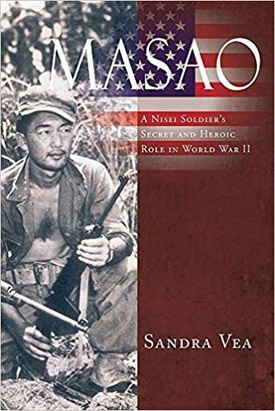As a visit to almost any American new or used bookstore will quickly confirm, military history is an exceedingly popular genre of literature. This is particularly the case as it pertains to World War II, including that of the heroic role played by Japanese American troops. For the most part, the particular role that has commanded primary attention in this connection has been the exploits of the segregated 100th Infantry Battalion, the 442nd Regimental Combat Team, and the 552nd Field Artillery Battalion in the European Theater. More recently, however, long overdue notice is increasingly being accorded the valorous efforts of Nikkei in the U.S. Army Military Intelligence Service forces in the Pacific Theater. It is this topic that occupies center stage in native Seattleite Sandra Vea’s extraordinarily fine biographically-themed book on Kibei-Nisei Masao Abe (1916-2013). It revolves around, but is certainly not limited to, his front-lines service as an interpreter/translator soldier attached to the 81st Infantry Division during some of its most ferociously fought South Pacific campaigns.
Skillfully crafted in the fashion of a non-fiction novel, Vea explains that she has “reimagined portions of Masao’s story, rendering those in fictionalized form, although . . . carefully attending to the ‘facts’ of those stories as he told them” (p. iv). The book is divided into two main parts. The first of these focuses on Abe’s life up to 1925 as an English-speaking youth in San Bernardino, Calif., where in its small and tight-knit Japantown his father and uncle owned and operated a grocery store. It then shifts to his 1925-1936 years living with his paternal grandparents in an increasingly militant Japan and being educated in the Japanese language and culture while being prepped to become a Japanese Army officer. It then turns to his pre-World War II return to San Bernardino, as mandated by his father, and his having to endure his Kibei status among Nisei while working in the family grocery store, before being drafted into the U.S. Army.
Part II first covers Abe’s training at Camp Robinson in Little Rock, Ark., to become a medic, followed by his submission of a successful application for entrance into the fourth class of the MIS Language School at Minnesota’s Camp Savage. After due attention to his vigorous MIS schooling, it proceeds to Abe being ordered to the South Pacific in 1944, where he and other MIS soldiers did intelligence duty in a regular army regiment and thus required two body guards to protect them from being shot by Japanese soldiers and American G.I.’s alike. It culminates with Abe being shot in the leg by a Japanese sniper while trying to flush Japanese soldiers out of a cave on the island of Peleliu, thereby receiving a combat wound that earned him a Purple Heart. This part closes with the end of the Pacific War in August 1945 and Abe’s transfer, with fellow MIS interpreters, for extended duty in Occupied Japan under the command of General Douglas MacArthur.
Throughout Masao, Vea interweaves two elements. On the one hand, she narrates the ordeal suffered by the immediate and extended Abe family, both on the West Coast at the time after Japan’s attack on Pearl Harbor and during the war in both Department of Justice internment and War Relocation Authority concentration camps. More impressively, she shares with readers her close three-year relationship with Masao Abe, and how she simultaneously developed a loving relationship with him and periodically coaxed out of him on tape the fascinating details of his life experience, his family relations, and, most especially, his courageous wartime exploits.
This is an exceptionally well-researched and composed book, replete with an excellent complement of photographs, and lacking only an index. To learn more about this exemplary book before reading it, you would be well advised to read what the author herself has expressed so movingly in an online posting about its content and character.
MASAO: A NISEI SOLDIER’S SECRET AND HEROIC ROLE IN WORLD WAR II
By Sandra Vea
(Seattle: DMA Books, 2016, 360 pp., $18.99, paperback)
*This article was originally published by The Nichi Bei Weekly on July 19, 2018.
© 2018 Arthur Hansen / Nichi Bei Weekly








